#This is what happens when you realise you can draw photo realism
Photo
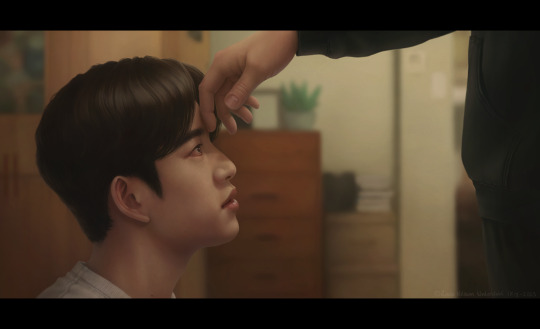
Ga On took a deep breath, knowing he had to apologize for how poorly he had handled the situation.
"I'm sor—"
That was as far as Ga On got before he felt a sudden but fleeting sting of pain against his forehead. He flinched and looked up at Yo Han, driven by equal parts surprise and disbelief. One of his hands rose toward the spot Yo Han had, apparently, just given a flick with his fingers.
"Did you just—"
Yo Han gently batted Ga On's hand away before brushing the backs of his fingers against Ga On's forehead, as if to soothe away the pain he had just caused. Ga On's stomach flipped as he stared up at Yo Han, eyes wide, having absolutely no idea how to react.
"Stop apologizing," Yo Han reprimanded. His hand lingered, the touch light — soft like a whisper — and yet intense enough to send a shiver down Ga On's spine.
For a confusing, breathless moment, Ga On just sat there, too stunned to move.
From Chapter 11 of Who Holds the Devil
____
I guess I’ve taken it upon myself to provide everyone with a second season of The Devil Judge even if I have to write it and draw the fake screenshots myself. Because, as per usual, I’m incapable of doing things by halves, both when it comes to my writing AND my art. If you want something done, do it yourself?
I hope you’ll like it! :D
#The Devil Judge#Kim Ga On#Kang Yo Han#Gahan#Art#Fan Art#KDrama#This is what happens when you realise you can draw photo realism#And you want to find out if you can do that even WITHOUT an exact reference#I'm not sure if it's hubris#Or insanity#Or just having no regard for your own limits#Or all three#But#In my defence#It worked#It's not AS good as when I copy straight from a reference#But pretty dang close#Since the scene only exists inside my head#Though I won't lie#I'm high-key panicking#It was a long time since I've been this invested in a drawing#Both in a good and a bad way#But it was definitely worth it in the end#I learned a lot if nothing else
226 notes
·
View notes
Text
Zombie Movie: I Am Legend (2007)
“Here’s Karen at the health desk.”
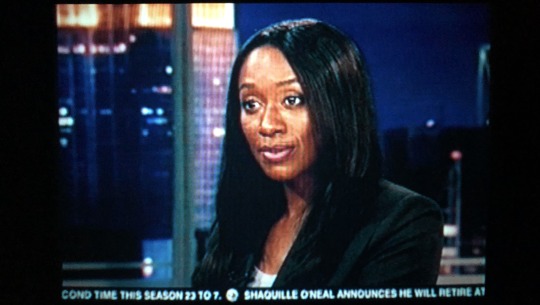
Karen from the health desk. (Picture: A female news anchor, Karen from the health desk.)
Language warning (sorry kids, but this is an MA15+ movie).
I shit you not, that’s one of the opening quotes of the movies. So, friends and enemies, welcome to the longest review I’ve done of a zombie movie yet. It’s 1:35am here in Australia and I’ve just finished rewatching I Am Legend, everything’s fresh in my mind and I’m hyped up on chocolate.
This movie has incredible tension, a fresh take on the zombie apocalypse, and it’s based on the 1954 novel by Richard Matherson, which inspired the modern day vampire and zombie movies. Why you may ask? Because it popularised the concept of a worldwide apocalypse due to a disease... now I’m beginning to realise that watching zombie movies during a global pandemic maybe wasn’t the best idea I’ve ever had. Any who.
YouTube rewind made me forget how bloody good of an actor Will Smith is, and boy does he deliver in this movie. Robert’s (that his character, btw, though I will probably end up just referring to the character as Will Smith) interactions with Sam the goodest girl in the world (she’s a dog) and the mannequins is incredible.

The goodest girl in the world. (Picture: A dog (I’m sorry - I don’t know dog breeds! I’m 99% sure she’s a German Shepard) being given a bath and head scratches by Will Smith.)
Now: three things to look forward to in this “review” (assuming you read the spoilery section below). One: how realistic is this apocalypse? Two: there’s a dog. Three: zombie vampires. Vampire zombies?
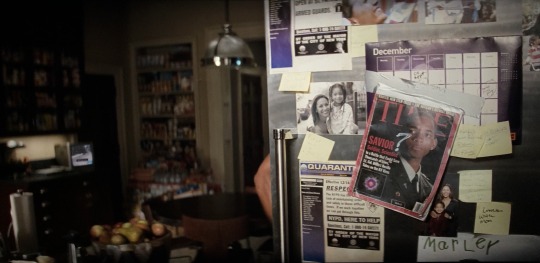
Backgrounds details! (Picture: Will Smith opened the fridge. On the fridge door are photos of his wife and daughter, a calendar dated for December, a drawing with “Marley” written in kids handwriting, post-it notes, a pamphlet with the heading “Quarantine”, and a Time Magazine cover of Robert Neville (Will Smith). The title reads (heading) “Saviour?” (sub-heading) “Soldier, Scientist” (body of text) “In a Battle that Could Save Thousands of Lives, Lt. Col. Robert Neville Takes on the XV Virus.”
Also, there’s banging in my house at the moment and when I say I’m peaking. I’m going to need to listen to some music while I write this.
Read on for a fun time! Spoilers ahoy!
Realism (the really relevant part. Yikes)
Okay, so what’s this fresh take on the apocalypse? Basically, this doctor cures cancer and it all goes to shit from there. I’m not 100% on the logistical jump from “destroying cancer cells” to “humans (and animals) becoming bloodthirsty mutants that burn in the sun” - for instance, this is just my sci-fi high-school biology and physics brain working here, cancer is basically a rogue cell that mutates other cells and destroys them in the process, yeah? So if the doctor, like she said, uses these cancer cells to work for the body and in the process “cures” cancer, wouldn’t the humans just... infect each other and the virus would kill the host if it went south? Given, that did happen in like 90% of cases as Will Smith explains, but where does the sunlight allergy come in? Is cancer afraid of UV? Confused, but I digress.
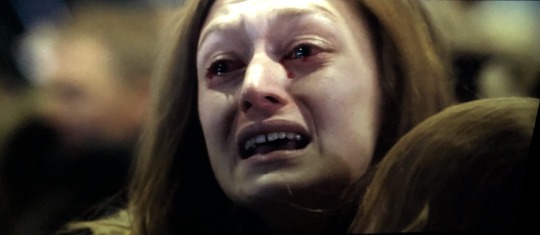
... Is that my queen, Missy, from Umbrella Academy? (Picture: A woman with blood leaking from her eyes, holding a child and shouting for help.)
The scene where they’re listening to the radio and the guy is like we’re “issuing a military quarantine of New York City” I’m like bitch you wish. Unrealistic. The USA currently (9/10/2020) has the highest cases of COVID-19 in the world (for future historians and poor school children, it’s at 7.68 MILLION cases, no statistic for recovered cases for some weird ass reason, and sadly, 212,000 deaths. For reference, here in Australia we’ve had as of today 27,206 cases, 24,807 recovered and 897 deaths. New Zealand, who went into hard lockdown, had as of today, 1,864 cases, 1,800 recovered, and 25 deaths, with a period where there were 0 new cases for several days.)
Though, with that in mind, everyone going outside and gathering in large crowds? Realistic.
The actual movie part
Praises time! Will Smith has a stockpile of food. Also, him getting Sam (the dog) to eat her vegetables like she’s a little kid? Cutest thing ever.
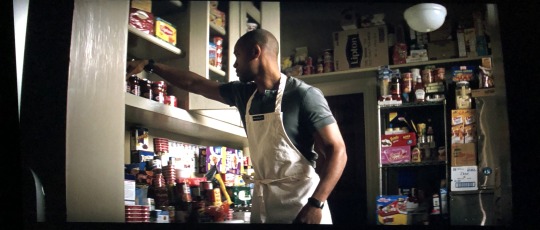
Stockpilesss. (Picture: Will Smith wearing an apron and preparing a meal in a kitchen chock full of food items, including things like Pringles and spaghetti sauce.)
Setting alarms on his watch for sunset? Brilliant, smart idea, fantastic. Re-enforced windows and door, AND booby-trapped house? Incredible, genius. Setting traps to catch the zomvamps? (like the dumb name I just came up with? Don’t worry, I’ll reveal the stupid arbitrary name they ACTUALLY came up with later) Talent, intelligence.
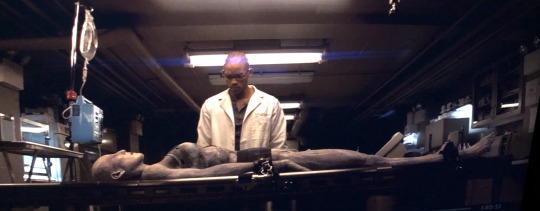
Dude, why wouldn’t you restrain the head/chest? You know, the part that can bite you? (Picture: Will Smith in a lab coat standing over a female zombie-vampire who’s been secured to a metal bench by the wrists and ankles. Medical monitors are connected to her.)
Now, Will Smith is out here looking for a cure. And by looking, I mean actively creating. In a lab. He washes his hands before going in - *chef’s kiss* follow his example - and unlike other zombie movies where it’s super dramatic in the hunt for a cure, this is a lot more chill considering it’s a) been 3 years and b) is more like how science actually works. Trials, tests, animal test-subjects (there is a debate about the ethics of this which I won’t go into here) (I mean a debate in real life not in the zombie movie haha) and human test-subjects.
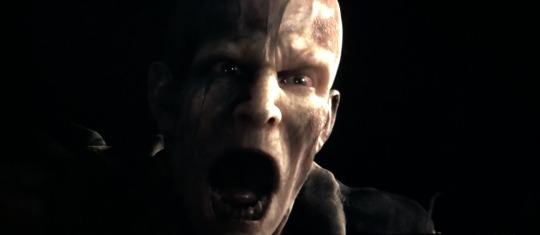
“Did you kidnap my girlfriend, bro?” (Picture: bald, pale muscular dude-bro-looking zombie-vampire roaring in rage.)
The mother-fracking zombies
I have to say it: these are the most dumbass looking vampire-zombies. I say vampire-zombies (zomvamps) because they avoid sunlight but also eat people?
Now, unlike most zombie movies, these are really bloody intelligent zomvamps. At one point, after setting a booby trap and catching a zomvamp after stumbling into a nest of them, Robert says “They’re not showing any human social behaviour.” Hahahaha. Okay bitch first of all dude bro screamed when you kidnapped his mate, secondly dude bro has pet dogs, thirdly dude bro fucking caught you in a trap. He took revenge on you there, love. He followed you home!
The zomvamps are apex predators, can climb, run, hunt in packs, communicate with each other, set booby traps, make coordinated attacks, follow you home, learn where you live and remember it, and holy fuck humans had no chance.
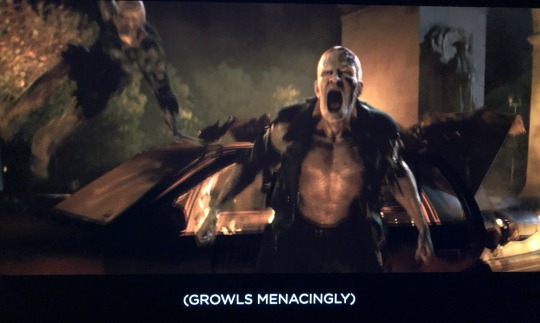
Thank you for clarifying, because I actually found this quite funny. Like, look at him! (Picture: dude-bro zombie-vampire from earlier growling in front of a flaming car. The zombie-vampires are very CGI, pale, fish-person looking things with pale skin and completely bald of hair. This guy is wearing ripped clothes. The caption reads “Growls menacingly”.)
Random things I have in my notes but haven’t mentioned yet (yes I took notes)
What’s with the apocalypse and mannequins? Looking at you, Five (Umbrella Academy).

(Picture: Will Smith looking at a “female” mannequin, who is dressed in a coat and black bob wig. They’re in a movie store. Funnily enough, behind the mannequin is the “Adult” section of the films.)
I agree with the fuck-that-shit sentiment when you see a mannequin suddenly appear in a different part of the city - like how in the hell??
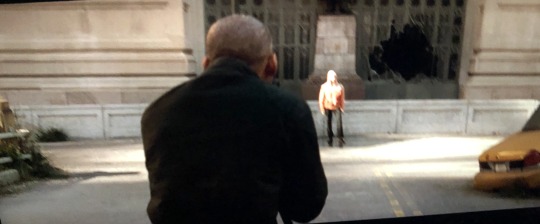
(Picture: Will Smith aiming a rifle at a mannequin in an orange jumper. Mannequin is usually located outside of the movie store, yet here it is randomly in the middle of the street at the end of a T-section. There are tall glass windows behind the mannequin, and the window to the right has a giant, gaping pitch black hole in it. It’s presumed that there is a nest of zombie-vampires in there.)
... so is this a booby trap for humans or for zomvamps? Because the former makes sense if that dude bro zomvamp analysed Will Smith’s trap from earlier and remade it (hence dropped the car off a bridge to string him up), and the latter doesn’t really make sense because a) you’ll only catch (and probably kill) one zomvamp and why would you want only one unless you’re Robert and two why tf aren’t you meeting up with Robert he’s been broadcasting and racing around town hunting deer (elk?) in a sports car.

I’d like to know how hard it actually is to do like a weird sit-up and get yourself free of one of these kinds of traps. Am I dumb for thinking it’s not that hard? (Picture: Will Smith is suspended in the air by a rope tied around his ankle, the result of a booby-trap. He’s struggling to free himself.)
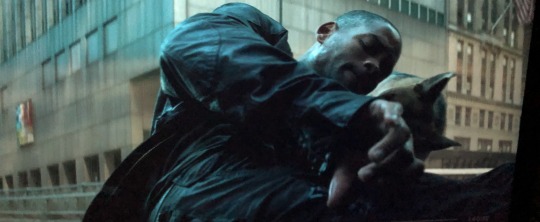
Come on, you’re literally a doctor and a soldier. Don’t tell me you’re actually considering pulling that out? (Picture: Will Smith has been impaled in the leg by something. It looks like he’s about to attempt to pull it out. He’s in the middle of the street as the sun sets, and Sam is right next to him.)
Sam is a queen. Here are some photos of her.

(Picture: Robert Neville’s wife carrying a baby Sam - Sam is a puppy, by the way, and very adorable. Neville’s young daughter is walking out of the gate to their house behind her mother.)

(Picture: Will Smith in a flashback saying goodbye to his wife and daughter and crying. Sam is licking away his tears.)
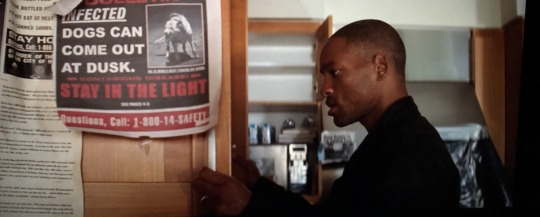
Sometimes I hate foreshadowing. (Picture: Will Smith searching a house. He opens a cupboard and there’s a newspaper article with a picture of a zombie-vampire dog. The article reads “Infected dogs can come out at dusk. Stay in the light.” There’s a number to call for questions.)
Worst birthday ever. Now I’m sad and there’s still half the movie left.

(Picture: Will Smith sitting on the floor of his lab, hugging Sam, who’s just been bitten by infected dogs.)
Get Shrek’d.
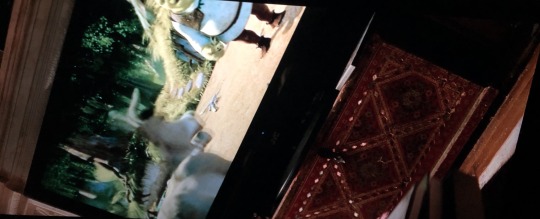
(Picture: The ‘Shrek’ movie playing on the TV in Neville’s house.)

Ma’am, do you not know how to ration? That is such a waste of food. (Picture: the woman and kid who rescued Will Smith have cooked breakfast. She’s cooked way too many scrambled eggs for two adults and a kid, and all the of the bacon for literally no reason.)
Oh yeah, wanna know what they call the zombies in this movie?
Dark Seekers. They dropped that one on us well into the final half of the movie. Dark Seekers? Really? I won’t get into how dumb that sounds when you had two options to choose from - vampires and zombies. Hell, go with my suggestion of zomvamps, even vampzoms. Dark Seekers? Sorry, I get hung up on dumb zombie-alternative names. Sure, I get the atmosphere might be ruined by calling them vampires or zombies, but not even lying I didn’t realise she said “Dark Seekers” until I turned the CC on to grab a quote. I thought she said “Dog Keepers” hahahaha. “The dog keepers got them.” My defence is that the dude bro did keep dogs.
Finally, wrapping this up at 2:15 before I add in pictures, you’re telling me approximately 100 zomvamps made a coordinated attack on Will Smith’s house to eat... 3 people? That’s like me and a hundred mates descending on the pentagon for a fucking snickers bar. We’d get like an atom each.
Oh, what’s that? They’re here to rescue one person? Really? Really? How in the fuck are they even zombies if their primary purpose isn’t to eat humans. I’m disappointed. But points for a fresh take, at least.
Now one of the things I remember about this movie is that is has an alternate ending. The actual ending (huge spoilers but then again, you’re in the spoiler section) has Will Smith sacrifice himself (read: blow himself and the zomvamps up with a grenade) to defend the cure and save his new friends. The alternate ending, which was scrapped due to negative audience reaction, has Will Smith communicate with the zomvamps who like actually calm down and listen to him. He gives the dude bro back his friend, and... no one dies.
I’m sorry, how is an ending where, sure, a cure isn’t found YET, but, the “villains” of the movie are humanised and a new side of them is seen that shows, hey, maybe there’s another way through this apocalypse, better than an ending where Will Smith dies? Make it make sense test audience. Because, remember, there’s still a whole bunch of immune people living out here, and three of them are currently in the same room. Robert’s only been working on the cure for 3 years. How many years do you reckon it takes to cure cancer? Hint: it’s ongoing in real life. Just because the cure isn’t found in the movie doesn’t mean it won’t be found. Ughhhh. I digress again.
I have more random photos but I am very tired. If anyone’s interested in hearing me roast butterflies, the world not actually ending in 2012, and a missed pun about Until Dawn (even though it was made like ten years after this), and a quick analysis on Robert Neville and God, let me know :)
Have a great day everyone, wash your hands, social distance if possible, and quarantine. Just because the COVID-19 virus isn’t turning us into zombies doesn’t mean it isn’t hurting us.
Worldwide statistics, 9/10/2020: 36.2M total cases, 25.3M recovered, 1.06M deaths.

(Picture: Will Smith saying “I like ‘Shrek’ after just quoting an entire scene of it to win a kid’s trust.)
#zombie#movies#I Am Legend#Will Smith#vampires#zombies#Dark Seekers#quarantine#doggos#shrek#apocalypse#mannequins#The Umbrella Academy
2 notes
·
View notes
Text
Storytelling in Visual Communication
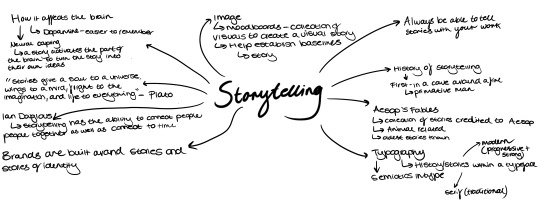
For this contextual study lecture, I learnt about storytelling and how it is integrated into design and how it is important to use throughout my work and the impact storytelling has us psychologically with being able to expand upon ideas as well help with our memory. From the start of the creation of humans to today, storytelling is something in our lives that we don't even realise and within graphics, it is built in brand design and in advertising. Sometimes it is also clear, with including a story as the main focal point of the design to capture the audience and engage with it emotionally and process their own thoughts and ideas from it to engage with what they are advertising.
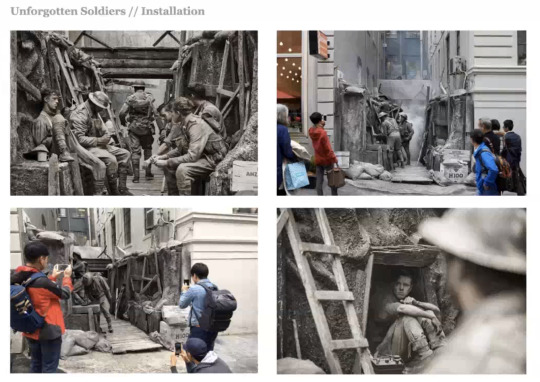
The Unforgotten Soldiers is a living picture of an 8 hour performance by the agency DDB working with Sky and the History Channel, 100 years after the First World War. After the last soldier of WW1 died, their aim was to reconnect with the past and don’t lose sight on the impact and tragedy of the war which would be lost through the grainy black and white images. It told real life stories of the Gallipoli campaign fought by New Zealanders to connect that emotional aspect to it by bringing those stories to life, to form an emotional connection to the soldiers as well as using real audio sound effects. They also used the power of social media, with using a hashtag to share the performance online to connect with people around the world and get the conversation going. This performance I thought was very powerful as it shows the realism of the negativity of the war to get people thinking of the actions of today to prevent something like this from happening again and how we should thank the people who risked their lives. I also like how they made the people in black and white, it juxtaposes the real life world as well as symbolise history and how we see the First World War and gives a negative look to there atmosphere with a dull palette. Using an alley way I also liked to show the cramped conditions to give a realistic look so that the stage design at the back is not given away, to make it look as realistic as possible.
https://www.dandad.org/awards/professional/2016/spatial-experiential-design/25512/unforgotten-soldiers/

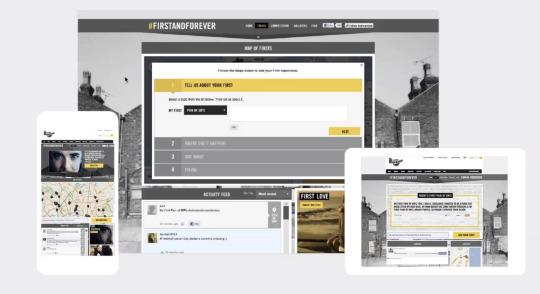
To celebrate their anniversary, Doctor Martins wanted to convey the British culture behind the shoe company. By doing this, they got people to digitally share their stories with a GPS location of where they brought their first pair of that brand of shoes. This led to a 17% increase in sales year on year which was because the people felt part of the brand and that effective storytelling makes the people feel a part of community and welcomed.
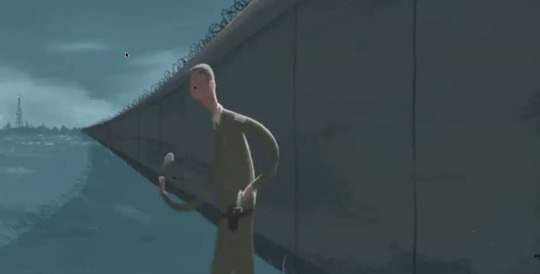

VCCP Berlin’s work for AirBnB displays a true story of belonging. Displayed as being a true story, we feel connected to the characters and the story itself, making us remember the brand more easily, linking back to the psychology behind storytelling. The idea of this negative perception of a past idea holding someone back and then going to change the past I really liked as it communicates the idea of travelling and learning about things and making positive memories, linking back to the company.
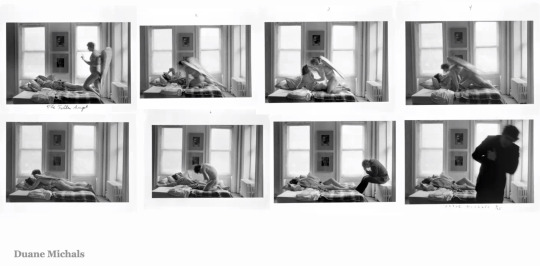
Michals’ photo sequence mirrors the film industry with using frames to tell a story. He displays a controversial yet moral warning through a simplistic black and white frame by frame, telling a story of guilt and as it feels like a movie, we have an emotional connection to this story, making it overall effective.


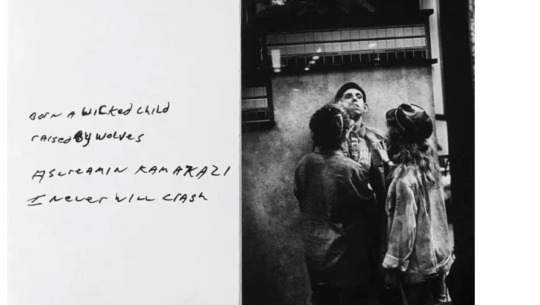
I really like the work of Jim Goldberg and how he combines this jarring but simplistic typography to the photograph to communicate this negative and brutal atmosphere of a marginalised youth. The hand rendered typeface portrays this emotional connection behind the story telling words and photographs and the black and white deepens this negative look to the work with this gritty feel to the photography and type composition being quite organic and not flowing across naturally across the page. Goldberg captures the disturbing lives of teens on the streets of San Francisco in the 80s and 90s in a narrative fiction and documentary.
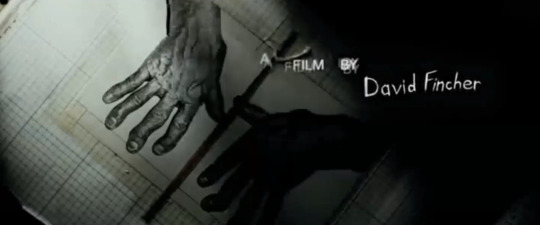


I also really liked the Seven title sequence which reminds me of Stefan Sagmiesters’ scratchy typography. it builds this narrative of disturbance and negativity before the film starts to give a good insight into what the film is going to be about as well as set the tone so it will be more impactful to the viewer. The type is quite small but is impactful through its animation to set the scene with glitches and layering and the gritty typewriter typeface choice which I really like. The colour palette also sets the tone with the gritty dull texture with yellow tones to resemble age.
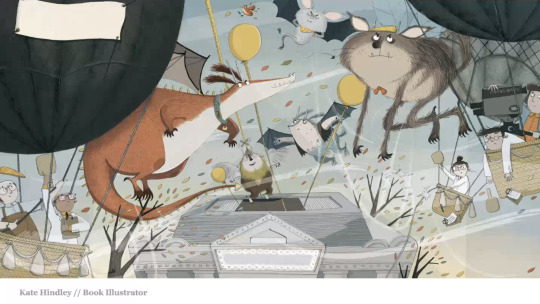
Hindley’s work embellishes a lot of detail for children illustration. She keeps in mind a sense of space, place and flow in each piece and due to the many elements, each page tells a story within itself. She uses the full bleed to create an atmosphere to draw the children in and get them interested in the story.
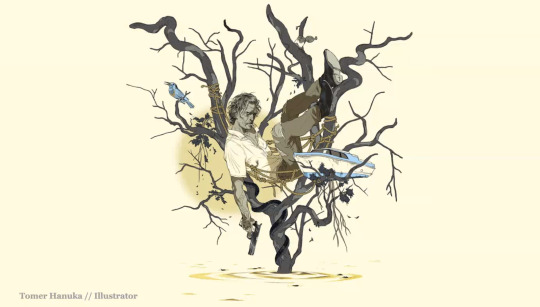
Hanuka’s work also explores narrative in one picture but in a different way. In this piece he communicates this man-made struggle through different elements of the piece but keeps it contained within a bisected composition to enhance that negative atmosphere as well as drawing our eye into the work and making it condensed yet impactful.
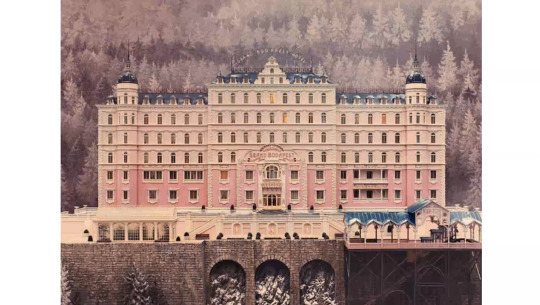
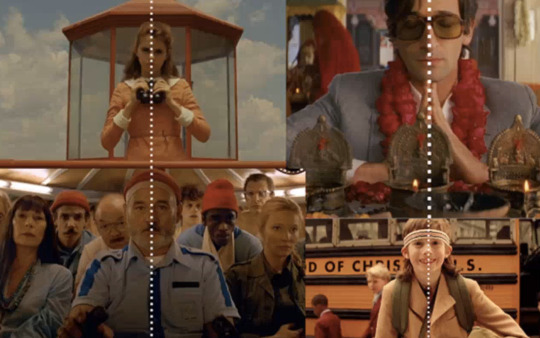
Wes Anderson work uses a one point perspective to convey narrative. This intrigues the viewer by forming a more personal connection the camera as they make eye contact with you. It has also this warm palette which can also convey this communication with this welcoming environment to form a deeper connection to the character.
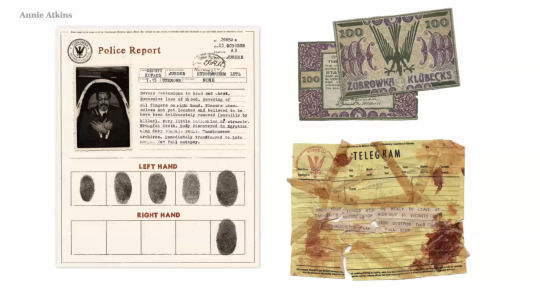
Annie Atkin’s work produces props and typography for film production. Atkin’s work explores typography from the past with letterpress designs and refers back to traditional ways to form a more authentic piece of prop work and to gain inspiration, she collects pieces from the past. She wants to transport people to another world in her work and tell a story within her prop design. I like how she focuses on the little details with the paper type as well as any wear and tear that is needed to make it authentic. in the Wes Anderson films, the props are in the front of the world to let them tell the stories.
https://www.annieatkins.com
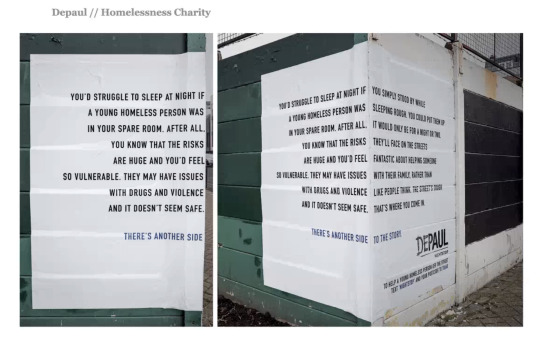
Depaul’s work I really like with using the environment to change a story and show a different perspective. It shows how impactful just copywriter can be when displayed in a certain way and it builds on the idea of breaking down these pre-conceptions that we have.
This lecture has taught me a lot on how I can design for a story to form an emotional and memorable connection to the viewer in a range of different ways and using a range of different media.
0 notes
Photo
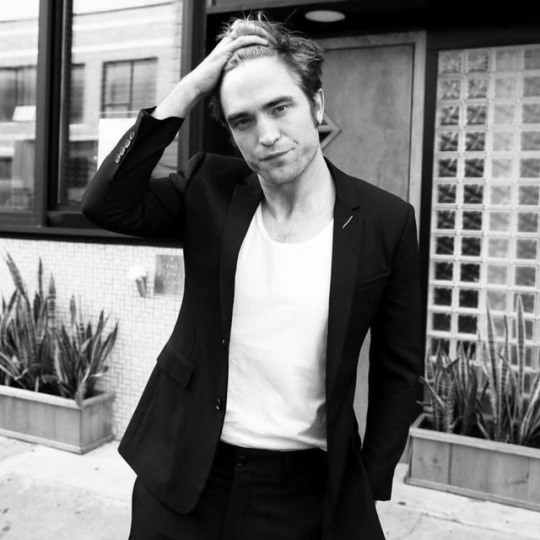
NEW INTERVIEW WITH ESQUIRE UK
Robert Pattinson’s Darker Materials
Three years since he last met Esquire, Robert Pattinson remains dedicated to redefining himself as an expressive actor beyond the teen-hero hysteria of his early career. In his new film, gritty heist thriller Good Time, he finds redemption as a cold-hearted criminal and achieves the almost supernaturally impossible — walking around New York unrecognised
When he was shooting his latest movie, Good Time, in Queens last year, Robert Pattinson would start the day with a run. And he’d be recognised, as always. Such is life for the 31-year-old actor formerly known as Edward Cullen, the broody vampire in the Twilight movies. Over five years and five films, he inspired such a vast and hysterical following that more than any star of his generation he became a prisoner of his own celebrity. He was forced to sell his home in Griffith Park, Los Angeles, because of paparazzi at the gates. They trailed him everywhere, entailing all kinds of Jason Bourneism, like swapping clothes with friends and assistants in restaurant bathrooms, sending them off in decoy cars, up to five at a time. And if he failed, if just one tweet went out with his location, then armies of paps and Twi-hards, crazed and shrieking, would come galloping over the horizon like the Dothraki hordes.
But after each run, something extraordinary happened. He got into costume as his character in Good Time, Connie Nikas, a Greek-American criminal from Queens, and just like that, the staring stopped. He could walk down the street unmolested. This latest film is his best performance by some distance, an electric, adrenalin shot of a movie that will establish him as one of the most vital actors of the day, so there’s that. But this gift of anonymity may be equally precious. Good Time will put Pattinson’s name in lights while simultaneously helping him blend into the background. Shooting it gave him his life back. It’s handed the prisoner a set of keys, because as Nikas, Pattinson could move through the world again. He was free.
“It was amazing. Invisibility cloak,” he says. “I’ve always wondered what can you do, just a simple thing to your face so you can just… exist in the world. And now I know. Darken your beard and put on these acne scar things and people will look directly into your face, and not even a glimmer. It’s fascinating. Also earrings, there’s something about fake diamond earrings.”
He looks a bit Connie Nikas today, actually. We’re in a booth at a private member’s club in West Hollywood, and he’s wearing a sports jacket on top of a hoodie, never mind that this is the height of summer. The jacket’s Lacoste; very hipster I tell him. And he laughs.
“Is anyone not a hipster now? I think it’s just normal culture,” he says. “Anyway, I found this on eBay so, you know… I’d be cool if I had it from school, like, ‘I’ve had this for aaages. I still dress exactly like I did when I was 12.’ Ha ha ha!”
He looks happy, energised, garrulous. The hands move around, the Lacoste rustles, he’s chewing on a toothpick and tipping his head back to laugh and laugh. He looks like a guy who made a bet on himself and won, which he did. And this is what he’s here to tell us: chase what you want in life, take the risk, who cares what people think in the end. This is your life, not theirs.
The last time I saw Pattinson for Esquire, three years ago, he’d only just made that bet. He came over to my house for lunch, and we got the barbecue going, there were beers — things celebrities never do — and we talked about The Rover, a film he made with director David Michôd (Animal Kingdom). It was his first major step on the route away from Twilight and towards Good Time, a life that he actually wanted. He’d made a pact with himself to only pick roles that were unlike anything he’d done before, that would broaden him as an actor and human being, and to work only with film-makers he loved, with no compromise. So post-Twilight, his CV is just one auteur after the next, in a string of movies that don’t make money but are always compelling. Besides The Rover, there’s his second film with David Cronenberg, 2014’s Maps to the Stars; The Childhood of a Leader directed by his friend Brady Corbet; The Lost City of Z with the film-maker’s film-maker, James Gray, not to mention the Safdie brothers, Josh and Benny, who made Good Time.
Back in 2014, he was living next to rap impresario Suge Knight in a gated community on Mulholland Drive, still in hiding from Twilight fans. It was a secluded life, with just an inflatable boat and an assistant for company. “Aww, I miss my assistant,” he says. “He’s now a real estate agent in Phoenix. Couldn’t take it any more. 'All you do is play video games!’” Most of Pattinson’s time was spent in one room, watching films and reading books, much as it is today.
“Probably my fondest memory from that house is watching the first three seasons of Game of Thrones over four days.” He laughs. “So lame that’s my fondest memory!”
He dreamed of escape. #Vanlife on Instagram became an obsession, posts celebrating the nouveau hippy world of attractive young surfer types living the free-spirit life in camper vans, free of all material possessions beyond a hammock, a book of poetry and a mobile phone to upload selfies to madden people in cubicle offices.
“I nearly did it,” Pattinson says. “I was 100 per cent going to live in a van, but not just any van — a stealth van! It’s a special niche, not like living in a trailer. Stealth vans looks like a normal Transit van, so you can park on the street, put signs on saying you’re a plumber or whatever and no one would notice.”
Van life promised anonymity, freedom, mobility: all the things he missed and wanted.
“It’s that thing, where you can just leave in the middle of the night and, like, drive to Nebraska,” he says. “And with solar power, you’re totally off the grid. I’d love that so much. And I was like, I’m still young, this is my chance…”
So he looked into it. The Mercedes-Benz Sprinter looked tidy; it had a toilet and shower in the back. But no.
“The Sprinter’s too fancy. It draws attention. So I visited different companies to retro- fit Transit vans but it’s complicated,” he says. “Once you build [in] a toilet and shower yourself, you can’t get it insured and blah blah blah.”
Still, he hasn’t ruled it out. One day, maybe. For now, though, instead of Nebraska, he moved five minutes down the road, to another secluded mansion in the hills. Only this time it’s not quite such a Spartan existence. He lives with “Twigs”, aka FKA Twigs, the British singer, and their little dog Solo. He won’t talk about her, though they may be engaged after three years together. And one can’t blame him; the Twi-hard fanbase has already subjected her to a torrent of racist abuse. Which is partly why they spend half their time in London, out east near Hackney Downs (hipster level: high). Pattinson gets hassled much less back home. “I go around on my bike,” he says, “so I’m basically a ghost.”
He was deep into #vanlife when he saw a still from the Safdie brothers’ movie of 2014, Heaven Knows What. It was just a close-up of the actress Arielle Holmes in a pink/blue light, her eyes sunken and strung out as if on heroin; she was playing a homeless junkie, a life she’d led until Josh Safdie approached her in a Manhattan subway and asked to make a film about her. The realism was palpable. And Pattinson was hooked at once: he had to work with these people.
“It was so cool, this photo, it had an amazing vibe, but also they’re American. Normally with an image like that, the director turns out to be Czech or something,” he says. “And my agents hadn’t heard of them either, so I knew I’d found something before anybody else.” This is what Pattinson loves more than anything — making discoveries.
Without even seeing the movie, he wrote the Safdies an email rich with compliments, a tried and tested ploy. “I basically say, 'Look, I’m not playing. I like very little and I like this thing you did, I think you’re good, and I just… know!’ And after that I call repeatedly.”
He’s done this with James Gray, with acclaimed French film director Claire Denis (who’s writing and directing his next film High Life). It’s a winning strategy. “I realised about four years ago, this is the best way to do it. I don’t even tell my agents.”
At first, Josh Safdie was hesitant. He was working on a movie about New York’s diamond district and Pattinson just wasn’t right for it. But they clicked, and once they met up, Josh saw something: “He has a wounded war veteran vibe to him, like there’s a major trauma in his life and he’s constantly trying to hover, trying not to be seen. I thought that was perfect for a guy on the run.” So the Safdies created a project for Pattinson, essentially writing him a movie.
“The thing about Josh and Benny,” Pattinson says, “is their energy and drive. It’s astonishing. And that’s how their movies feel, like there’s too much fuel in the car! I wanted that energy, something superkinetic. A lot of the stuff I’d done before was reactive, so I wanted to be forced into a situation. That’s their tone: runaway train. Their genre is literally panic. And that’s kind of who I am as well. So I said, 'Just push push push, be as audacious as possible.’”
The story centres around Connie, a sociopathic street criminal who can’t stand the thought of his mentally challenged brother Nick — played brilliantly by Benny Safdie — being institutionalised. So Connie takes him on a bank robbery, the first of several terrible decisions, each one cascading chaotically into the next. It’s a film that seizes you by the lapels and doesn’t let go for 100 minutes.
Unlike anything else he’s done, Pattinson was involved throughout the writing process. He was in the jungle in Colombia at the time, making The Lost City of Z, a gnarly experience by all accounts: he has stories of picking maggots out of his beard, and crew members being bitten by snakes. But at the day’s end, he’d find a volley of emails (there’s wi-fi in the Amazon, apparently) from the Safdies about Connie Nikas, about criminals, about the world of their movie.
They worked together painstakingly on Connie’s backstory, and Robert read all the books the brothers were inspired by, The Executioner’s Song by Norman Mailer and In the Belly of the Beast by Jack Henry Abbott. He watched the documentaries they sent over, notably One Year in a Life of Crime (1989) by John Alpert, and episodes of Cops, the Nineties reality TV that featured police chasing down and arresting a whole menagerie of street criminals. Josh calls it “America’s greatest TV series”. There would often be dialogue or behaviour that would be useful in building Connie Nikas. By the time Pattinson was ready to move to Queens, he was already halfway there.
Pattinson doesn’t do method; he’s more or less untrained, apart from a short stint in the Barnes Theatre Company aged 15. The Safdies introduced him to a new level of improvisation and research. They had Robert as Connie writing Nick letters as though from prison. Then they went on a tour of the Manhattan Detention Complex.
“Rob came as Connie, but he didn’t have the accent yet so he just looked around and kept to himself,” says Josh Safdie. They met people that Connie might be friends with. “My friends at Lucky’s Automotive Repair in Yonkers, basically. We started bringing Benny in as Nick then.” And from there, Rob and Benny took their characters out into the world, going to Dunkin’ Donuts, even working at a car wash together for a week.
“We had Nick drive the cars off after they went through,” says Benny. “But Nick has issues. He can’t do what Connie wants him to, so there was tension between them, it almost got violent. And that’s what we wanted. We wanted to give Rob a history of the emotions he would feel in certain moments.”
Critically, though, no one clocked Pattinson through all this. The car wash manager knew who he was, but no one else did, and they didn’t ask. It was a revelation. As Connie — with the clothing, hair and makeup — Pattinson could go unrecognised to such a degree that when they shot a scene toward the end in an apartment block, local residents didn’t even see him as an actor. They knew a movie star was in their midst but had heard it was Bradley Cooper.
“So, I was in this packed elevator and people were like, 'Yo, you like Bradley Cooper’s security guard?’ It was amazing,” Pattinson says. One of the joys of Good Time is remembering just how different Robert and his character Connie actually are. Pattinson is from south-west London, where he went to The Harrodian, a nice public school in Barnes. The son of a vintage-car salesman father and a model-booker mother, he grew up middle class and comfortable, an artistic type who set out after a music career (his band’s name: Bad Girls) before acting won out. He never came across characters like Connie Nikas in real life, so he imagined them; they were “fantasy figures”, as he calls them. And as such, no less influential.
“Growing up, you see Pacino and you want to be that,” he says, and then laughs. “I sound like a dick already, comparing myself to Pacino!”
But the point is sound; to Pattinson, Connie falls into the tradition of Pacino’s Sonny in Dog Day Afternoon, or Robert De Niro’s Johnny Boy in Mean Streets, the very characters who inspire people like Pattinson to become actors in the first place. Like all middle-class kids, he craved Connie’s authenticity.
“Everyone wants to say, 'I’ve gone through hardships’ or whatever. And some kids at school got so obsessed with looking tough that eventually they just were. They were mugging people. It’s like, 'Why are you mugging people? You live in Wimbledon!’ But you could see the progression,” he says. “It was born out of desire, not necessity. It’s fascinating.”
As for Pattinson, he just lied.
“I decided the best way to be real is to fake it! I used to lie all the time when I was younger. Like even though I had a London accent, I’d tell people I grew up on a farm in Yorkshire. That was about as gritty as I could pull off.”
His own life of crime was limited to stealing porn mags, aged 11, a story he told US shock jock Howard Stern. Eventually, he was caught, of course, the moment of humiliation seared into his memory as, in front of a line of old ladies collecting their pensions, the shop owner reached into his bag and pulled out one jazz mag after another.
“I turned on the tears and everything. I was desperate!” he says. “And when my mum heard, I totally threw one of my friends under the bus: 'Dan did it!’ It’s pretty terrifying when you’re backed against the wall. When people ask how would you behave in an emergency, now I know. I’m a wimp! I guess that’s pretty obvious!”
He says wimp, but there’s a quiet strength behind that self-effacing, affable front. Not everyone would confess to being a cowardly kid, or lying about their background, as insecure people don’t admit their flaws so freely. One of the reasons he was so drawn to the role of Connie, for instance, was the character’s lack of fear or shame. “I’m the opposite. Shame is the most crippling thing. I don’t even know what it is, it’s not connected to any other emotion. So I choose work to directly combat elements of my own personality.”
Josh Safdie spotted Pattinson’s ambition early on. “There’s a mania to him,” he says. “A manic desire to conquer the world. I was very happy to see it.”
And for all his self-deprecation, there’s a pride there in what he’s achieved post-Twilight. None of his subsequent film choices are obviously commercial, which suits him perfectly: low-budget indies, he says, have a lower bar to break even and with his international stardom, courtesy of Twilight in no small part, he can usually rest easy. Sometimes, his involvement is what makes these projects actually happen.
But artistically — and this is where he’s definitely not a wimp — every project is a risk, a test, a leap, yet another opportunity to fail and land very publicly on his arse. But that’s just how he likes it. The nerves, the threat of failure keep him interested.
“I like a big mountain to climb,” he says. “Some parts no one would think of me for, and I don’t blame them.”
Why go for those roles though, if they’re so against type? He shrugs.
“Probably just to prove I can, really.”
As the bill arrives for our meal, Pattinson chomps merrily through another round of toothpicks. It seems he’s been entirely sensible this time around. Not even one beer. “If I drink I’ll sound like a cock,” he says. “Actually, I probably sound like a cock already!” Anyway, he’s saving room for a cognac tasting later tonight with the Good Time producers. Not the kind of thing he does that often but these are heady times, what with the excitement around the movie, the critical acclaim. It’s such a buzz that even the press tour isn’t so painful. There’s room for some mischief at any rate.
On Jimmy Kimmel Live!, he tried to make fun of Josh Safdie but it came out wrong. He told Kimmel that Safdie had asked him to jerk off a dog. “It got [animal charity] Peta angry… everyone. It was like a whole American uproar for a day-and-a-half,” Josh says. “He’s a little shit, I promise you. But I love that about him.”
For the most part, though, Pattinson leads a fairly quiet life. It’s just him, Twigs and Solo kicking around at home. When he’s not working, he says, he’s looking for work.
“I’m basically flicking through the pages of Loot every day. I live the life of an unemployed person.” And for him that means watching art house movies, trawling film-geek websites and — so long as Game of Thrones isn’t on — cold-calling directors.
In a couple of weeks, he’s off to Germany for cosmonaut training for the movie he’s making with Claire Denis. It’s about another ex-con, this time in space as part of a human reproduction experiment. He mentioned it in a Q&A session in LA after a screening of Good Time, and no one in the audience had heard of Denis. Such is Pattinson’s particular taste.
“I don’t think Claire has made a bad movie in, like, 20, but I don’t know if any have been commercially successful!” he laughs. “That’s what it’s like in France. There’s a market there for less conventionally commercial movies, and that’s the world I want to be a part of. I just want to do stuff that people are only making for themselves, because it ends up being, by definition, more singular.”
The project that has him excited comes at the end of the year: The Devil All the Time, by Antonio Campos, who made Christine last year, a brilliant drama about a depressive Seventies news anchor in Florida. (For the record, Pattinson cold-called him too.) “There’s this line in it — and sometimes that’s all you need. And it’s like, 'Ooh… that’s scary to say’. Because it’ll go down in posterity and I’ll be the one saying it. You literally cannot get darker. It’s fucking dark. This character is an evangelical preacher in the South in the Fifties, but he’s gleefully bad and kind of funny and charismatic too. I know, it’s irresistible.”
Like, sexually repulsive, violent?
“Mmm… yes, all that. But you know when actors say, 'I refuse to play someone who does something bad.’ I’m, like, why? That’s fucking crazy. You can’t do anything bad in your real life. I think if someone needs to play a hero all the time, it’s probably because they’re doing really gross stuff in their real life.”
So you’re telling me, this is the only chance you get to be bad?
He laughs, and gets up to put on his Lacoste jacket, his camouflage, and flips up the hoodie underneath. Now he’s safe to leave our meeting without causing an incident. But it’s impossible now not to see shades of Connie, the sociopath bank robber from Queens.
“Yeah,” he grins. “The rest of the time, I’m an angel!”
Good Time is out on 3 November
27 notes
·
View notes
Text
Heterotopia
Heterotopia is a idea that is explained by philosopher Michel Foucault which describes certain Institutional, cultural and digressive spaces that are different somehow usually, disturbing, distorted intense, contradictory of transforming. Heterotopias are worlds that are within worlds which mirrors and also unsettles or distorts what is outside. Examples of heterotopia would be: graveyard, prisons, brothels, ships, bars, garden of antiquity, and many more, these examples are provided by Foucault.
Etymology
Heretrotopia follows the arrangement created by the concept of utopia and dystopia. The prefix part of the word Hetero- comes from Ancient Greek, (it means “different, other, another”) its is also fused with Greek morpheme τόπος (This means “place”) together they become “other place”. A utopia is a society or community that is imagined, it is the ideal place with high value or almost perfected qualities for the society. The opposite of this would be dystopia, this is a society or community that is low value or unsettling, dystopia translates to “bad place”. to put things simple a utopia is a place where everything is good; Dystopia is a place where everything is bad; Heterotopia is where things are different.
Foucault’s six principles
Become accepted in all cultures but in diverse forms (mostly as sites of ‘crisis’ or later ‘deviation’)
Mutate and have particular actions at other points in history
Juxtapose in one space many incompatible spatial elements
encapsulate spatio-temporal discontinuities or intensities
presuppose an ambivalent system of opening and closing, enter and exit, distance and penetration
Have a particular action in relation to different spaces as, for example illusion or compensation
Examples
1: Swimming Pool
-Feels like you are in another world but yet surrounded by the normal world.
-When under the water everything looks and feels different and also looks distorted
-Time feels slower especially when under the water as everything moves slower.

2: Disney Land
-Mirrors a world within a world, once your in it you the fact that the normal world exists is gone, this is because Disney land is design so that you cant see the outside world.
-Forget about time, you enjoy yourself so much in this new world that time flies by and you don’t realise what is happening outside.
-Has the potential of producing a world as itself.

3: Space Station
-Mirrors a world within a world (The space station is sort of looking down on the earth/world giving the effect of life being beyond just earth in another place.)
-lose sense of time (it also looks as if time isn’t moving as gravity is different and the normal world is far far away.)
-Distorted feeling (it would be difficult to understand sense of direction in a place like this.)

Heterotopia artist research
1: Beksinski



Beksinski was born in 1929 and passed away in the year 2005. He was a great polish artist as you can tell from some of his work shown above. He mainly used techniques such as photography, sculpting and painting, he specialised in dystopian surrealism. Beksinski did his drawings and paintings in a way he called ‘Baroque’ or ‘Gothic’ manner. His creations were created mostly in 2 sections. The first section would usually consider to have expressionistic colour with a very powerful style of utopian realism also surreal architecture, just like a doomsday setting.
2. Vincent J. Stoker



Vincent J. Stoker is a French photographer Heterotopia: the end of history is one of his series. He has a interesting style of art in his photographs, the setting in his images are usually shot in an abandon place like building with symmetry, this creates a very pleasing image to look at. His images give off the feel of heterotopia as the abandon places have turned into another world to what they used to be, looking at it you can sort of picture what the building used to look like which reflects the use of heterotopia.
3.Michael Sweerts
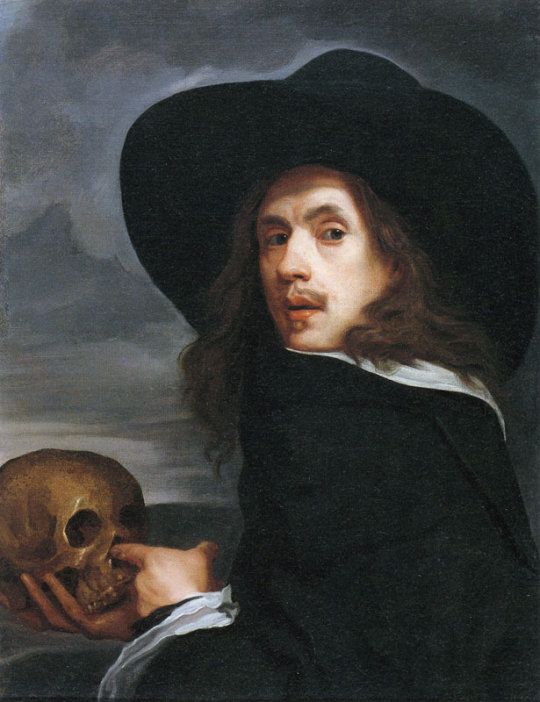

Michael Sweerts was born 1618 - 1664, he was a flemish painter/printmaker of the baroque style. he is most known for his figurative and genre portraits, paintings and tronies (tronies is common in dutch golden age in painting that shows overemphasised face expressions usually relating to a common type, or category of types). Michael Sweerts followed a peripatetic life, he worked in many places such as Persia, Rome, Amsterdam, Brussels and India.
He has learned a lot of his techniques from travelling to different places, for example when spending time in Rome he became connected to the dutch and Flemish painters of low-life scenes commonly known as the Bamboccianti.
Project Model Development
First we had three main ideas we wanted to build, we narrowed it down to a single idea by debating with our group which idea was most interesting and best shows Heterotopia. Me and my group settled on the idea of modelling a space station. We took many different things into account before making our decision, such as how we will create the space station? what materials do we have to work with? how is this a Heterotopia? is it possible? and so on.
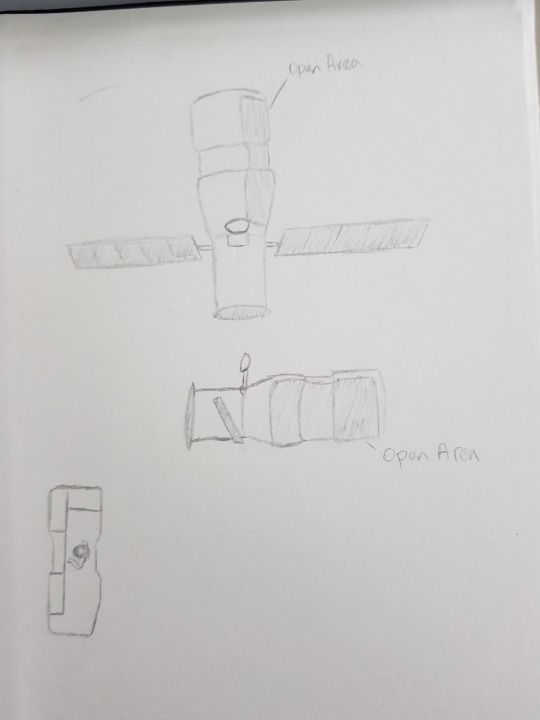
After settled on an idea we started to research space stations to see what they looked like on the outside as well as inside. With and idea of how they looked we began to sketch more ideas on how it would look and also work.

We all then look at each others sketch idea and then decided on which best fits what we were looking for, once the vision was there we started getting the process of developing the model, which first need measurement and a scale. Once finding the dimensions that would work well with our vision, we started to sketch out a few more idea such as the details of the space station and thought about how we can use the materials necessary to make our model as good as possible.

Here we have measured and drawn onto the cardboard (which will be used for our model) the back wall window part of our design, this section of the model will be connected to all of the rest so it is a crucial piece. after using this as a guide it was easier to find the correct size for the other pieces.

All of the piece for our models are now cut out and correctly measured, it was just a matter of sticking it all together. First we tried using a glue stick, it work but it didn't have the stability we were looking for so we found a glue gun instead which made things a whole lot easier and strengthened the model. Stick the models together was a bit of a fiddle but helping each other, one holding the pieces one using the glue gun also saved time and made it easier to a line the parts correctly.
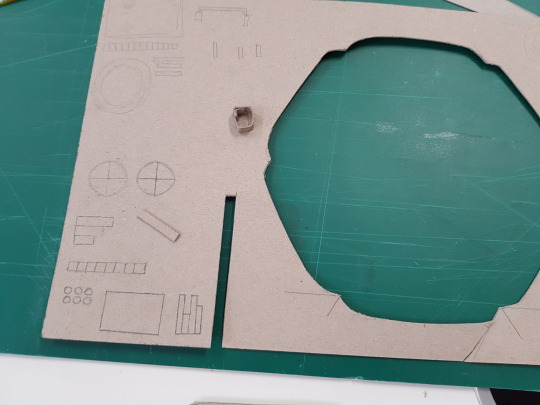
Here are some of the smaller details that we have drawn out onto cardboard, theses will be stuck onto the sides of the model, they will be used as the wires and little other pieces that are seen on the outside of a real space station. This will give the model a more realistic feel instead of just having plain sides with no definition.

Here we have the final model, overall the model looks great and turned out just as we wanted, we also added a spaceman character to peak the potential of the model, There we also other ideas that were took into account but however we thought the best decision would be to leave them out. The only con of our design would be a bit of glue is visible on the model, and it would look better with colour.

Other ideas we had:
Stand: We thought about adding a stand to the model, however we though the model would look better without a stand and there would be more and better types of images without one, below you can see the types of images we were able to achieve without the stand that would be possible with the stand.
Background: A space background was another thing we consider but it was shortly decided against it after little development. We thought the background would properly get in the way and it would also require the stand.

Here are some of the images we took during the photo-shooting of our model. I think they all look really cool, we had a bit of trouble sorting the camera, but once the setting were correct and to our liking we were able to create some really nice images. We used dark and lighting to make the environment give a space feel to it. We were able to get a lot of cool and different angles as well, we decided to use different colour lights (colours: blue and pink) to give an even more spacey feel. Other techniques such as composition were also used to enhance the look of the pictures, my opinion of the project would be it was really fun and we were all able to create something we were happy with. If i could do it again i would added more detail and colour.
Through the process of making this we all took turns doing different activities to contribute to the model, we all research and used references to do our own sketch ideas and discussed them to further improve our project design, we all took part in cutting out the pieces and building the model in some way, i found trying to stick the smaller pieces together a challenge however others in the group were able to do this a lot easier, which made it better for them to focus on doing things they were best at in a result of saving time.


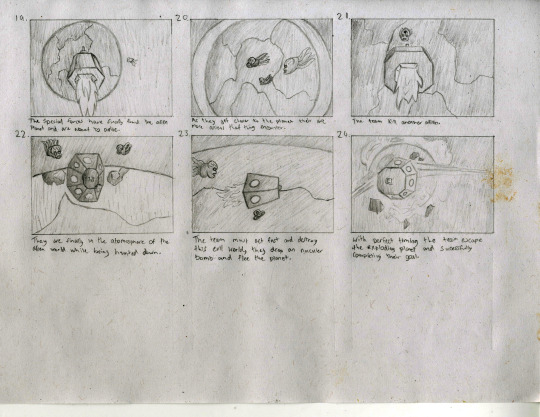
Treatment and Research
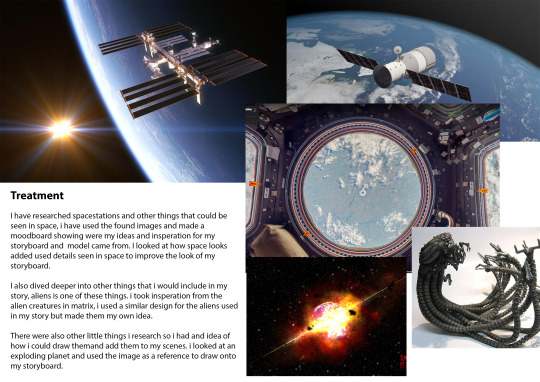
Mood board

0 notes
Text
Tattoo
Stiles was helping Derek clean out the attic of the old Hale House, ready for them to move in together, when he stumbled across some of Derek’s drawings.
You can read it on AO3 here. For @toofarforward.

Stiles was helping Derek clean out the attic of the old Hale house, getting ready for Stiles to move in – it was a sort of ‘out with the old, in with the new’ thing. Stiles didn’t care if Derek kept his old stuff, but the man seemed hell-bent on clearing the junk out of the newly-renovated house.
Derek had left a few minutes ago to pick up pizza for dinner and Stiles had turned his attention to sorting through an old suitcase of Derek’s old books and papers.
He had sorted them into piles for Derek to look at later: ‘burnt beyond readable but possibly treasured’, ‘burnt but salvageable if rebound’, and ‘in perfectly fine condition and to be sorted by Derek’.
He had finally reached the bottom of the suitcase when he found a small black folder filled with sheets of paper.
He contemplated leaving them alone, but that thought didn’t last long. Curiosity won him over and he pulled them out to look through them.
His jaw nearly hit the floor when he saw the gorgeous illustrations. They were beautiful sketches of the forest beyond the house, of members of his family, of wolves or butterflies, of the house and so various other things, all in immense detail and incredibly realistic.
Stiles picked one out: a strong portrait of a bold wolf.
He was so entranced by it that he didn’t hear Derek’s Camaro pull up, only the sound of the front door opening and the man’s booming voice calling out his name.
“Coming,” he shouted back, panicking as he quickly stowed the picture away in his backpack.
“I hope not,” Derek called back teasingly.
Stiles grabbed his bag and raced downstairs. He stopped in the doorway to the dining room and asked, “What?”
Derek smirked at him and Stiles realised what he had said.
The boy bowed his head and bit into his lip to stop himself from smiling back at Derek. “Really?”
Derek winked at him.
“You’re incorrigible,” Stiles scolded.
“You love it,” Derek whispered as he walked around the table and pressed a kiss to Stiles’ cheek.
Stiles smiled, reaching up and looping his arms around Derek’s neck. He nuzzled his face into Derek’s and whispered, “I love you.”
A week later, Stiles stood outside a well decorated shop with bold golden letters spelling out ‘Leviathan’ printed across the window. It was one of the city’s most highly rated tattoo parlours, much better than that damned place where Scott got his hideous tattoo that – to this day – Stiles hated.
He had booked the appointment the day after he had found those drawings in the attic. He had sent photos and met up to finalised the details – like the colouring, position and his insistence on the wolf having bright red eyes – and check on the tattoo artist’s sketch before today.
Today was the day.
He had already explained to the artist that he had an issue with needles and if he were to pass out he wanted to continue with the tattoo. The artist had chuckled at his determination and assured him everything will be okay, even if he did pass out.
So he drew in a deep breath and stepped into the parlour.
The artist talked him through most of it and assured him that the noise is the scariest part. She talked to him about his life, his studies, his boyfriend and the tattoo: the meaning and the reason why he wanted that specific drawing.
He was lying down and staring up at the ceiling, positioned so that the tattoo artist could work on the tattoo, so at least he wouldn’t see the needles going into his skin.
Stiles kept the conversations going, talking about how incredible his boyfriend was and how this tattoo – this drawing – was his connection with Derek, and if something were to happen between them, then the wolf will be his protection and his strength.
The hours passed by swiftly and there was a wave of sweet relief when the tattoo artist sat back and said, “All done.”
Stiles felt his heart pounding against his chest as he walked up to the front door of the house.
He stepped inside.
The house was quiet.
“Derek?” he called.
“Yeah?” Derek shouted from the attic.
“Can you come here a minute please?”
Derek made his way downstairs, eyeing Stiles suspiciously.
Stiles reached into his backpack and picked out a plastic sleeve. He held it out for Derek.
Derek took it from him and looked down at the piece of paper.
“You found on of my old drawings?” Derek asked.
Stiles nodded.
Derek looked at him, his aventurine eyes filled with worry. “What’s wrong?”
“Please don’t freak out,” Stiles pleaded.
Derek lifted his brow quizzically.
Stiles let out a heavy sigh and rolled up his sleeve to show Derek his new tattoo.
Derek was silent.
There it was, sitting perfectly on his bicep on a small rocky ledge that was wrapped around his arm like a cuff.
A gorgeous portrait of an alpha wolf on his arm: thick black fur and glowing scarlet eyes. It stood proudly, head tilted upwards as it stared across the distance with wise eyes and a stern expression. The grey and black fur had been tattooed with such detail that it held the realism of the soft locks. It wasn’t howling or snarling like most depictions of wolves, it simply stood as a proud defender, a true guardian: a true alpha.
Derek ran his fingers across Stiles’ skin and then glanced down at the drawing in his hand. It was his drawing, now displayed on his mate’s skin.
“What do you think?” Stiles asked timidly.
“It’s gorgeous,” Derek whispered. He looked up at Stiles, meeting the boy’s gaze. “But it doesn’t matter what I think. What do you think?”
“I love it, I just wanted it to be a surprise but I also didn’t want you to be mad at me because I kind of took your drawing without your permission and then snuck round behind your back to get this done and I just felt really bad that I didn’t tell you.”
“Stiles,” Derek interrupted, his husky voice soft and calming as he shushed the boy. He cupped Stiles’ cheek and leant in closer, bringing their lips together in a tender, loving kiss. “It’s gorgeous. It’s your choice and if you’re happy with it, then so am I. I don’t care if it’s my drawing or if you didn’t tell me about it – I’m touched actually – but it yours now: you’ve brought your own meaning into it. And if I’m going to be completely honest, it looks better on your skin than on my paper. But I have to ask, do you like it?”
“I love it,” Stiles repeated.
“I love it too,” Derek whispered, kissing Stiles again. “And I love you.”
#sterek#sterek fic#sterek fanfiction#sterek fanfic#tattoo#tattooed!stiles#tattoo!stiles#i don't know how to tag#one shot#established relationship#established sterek#drabble
89 notes
·
View notes
Text
Personal Study-An investigation into the use and development of chiaroscuro in fine art, film and photography
Chiaroscuro the Italian term which literally translates to light 'light-dark' originated from a form of Renaissance drawing on coloured paper, and was used to describe the technique of artist working towards light and dark using mediums such as ink, watercolour or body colour. There is some evidence that suggests the Romans or even the ancient Greeks applied this technique in their work. However, the European painting technique is first thought to be applied at its fullest by Leonardo da Vinci in the late 15th century.

Leonardo da Vinci, Benois Madonna, 1480

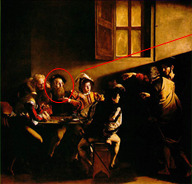
(Top to bottom)
Caravaggio, David with the head of Goliath, 1610
Caravaggio, The Calling of Saint Matthew, 1600
Da Vinci employed the technique to give his work the impression of three dimensions, for example in his painting “Benois Madonna”. The painting simply portrays a young Mary playing with her child, but Within the painting the use of Chiaroscuro is used to portray Mary as a warm and charming figure due to the lighter tones used on her skin, symbolising the light coming from the window in the foreground. The technique allows Da Vinci to achieve greater depth due to the intensity of colour creating a more intense feeling of luminosity and shade, which is achieved by Leonardo painting a broader range of light than what he appears to see. After Da Vinci’s use of the technique in the late 15th-century chiaroscuro became the main technique for many painters. By the late 17th century chiaroscuro became the common word for describing any painting that was dependent on the effect of extensive light and darkness. Michelangelo Merisi da Caravaggio was one of the artists that extensively used this technique. Caravaggio is widely recognised for his style of painting that utilises light to highlight specific points in his work. Caravaggio deployed the use of light to not only highlight specific points within compositions but also to heighten the emotional tension of figures within his work, and even deployed the technique to portray religious scenes. With support from the Pope Caravaggio produced a series of religious paintings depicting graphic sense full of blood and torture, all accentuated by sharp Chiaroscuro as seen in “David with the head of Goliath” and “The Calling of Saint Matthew”. The painting “The calling of Saint Matthew” depicts the moment Matthew first realises he is being called, refereeing to the biblical tale of when Jesus called him into his service. The use of chiaroscuro in the composition can clearly be seen. Figures within the composition are drowned in shadows and dark tones to help enhance the single point of light from the right shining across the image to lead the view through the image and illuminate the key figure of saint Matthew as I have highlighted in the image. Caravaggio’s use of the technique influenced many other artists within the 17th century, leading to the golden age of Spanish art when these works entered Spain via the commercial harbour.

John Alton, The Big Combo,1955
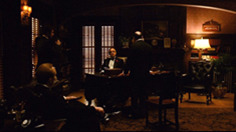
Francis Ford Coppola, The Godfather, 1972
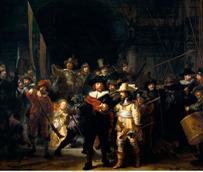
Rembrandt, The Night Watch,1642
The influence chiaroscuro has had can also be seen in different mediums. As time passed and technologies developed it was inevitable that the technique of chiaroscuro would be applied in film. The contrast between dark and light would eventually become key features in defining the genre of film noir. The reason why Chiaroscuro became synonymous with film noir is due to the low budget the films were produced on in the 1940’s and 50’s. Due to a low budget, the quality of the sets suffered so the cinematographers would drape these cheap sets in darkness to improve the look, shining intense light on specific spots when they wanted to highlight something, creating great contrast within shots, as seen in the screenshot from John Alton’s “The Big Combo”. The low-key lighting used by cinematographers was used to enhance the existentialism and fatalism that later became staples of the genre. The use of chiaroscuro intensifies moments and can be used a metaphor for a character’s personality when paired with low-key lighting because of its ability to show distinctness between light and dark areas. The technique was extremely successful and use has been used in film masterpieces such as “The Godfather”. The use of chiaroscuro can clearly be seen within the home office scenes within "The Godfather" with director Francis Ford Coppola using the technique to bring attention to the characters that he wants you to look at as shown in the still image I have included. Coppola’s arrangement of the mise en scene and use of chiaroscuro intelligently covers characters in shadows to highlight the godfather and highlighting the character’s importance. The way Coppola presents these scenes are reminiscent of "The Night Watch" by Rembrandt due to the similar use of lighting and muted colour tones to create a similar effect.
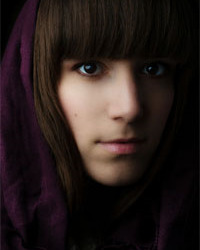
Alexandria Huff, Amanda, 2012
Rembrandt's use of lighting has also influenced the photography world with the term “Rembrandt lighting”. The term is used to describe the process of capturing a chiaroscuro image and is very popular due to its ability to capture compelling scenes with minimal equipment. Traditionally when taking photos, the key light is placed high, at the front and off centred with the fill light placed half height on the opposite side whereas with Rembrandt lighting the key is to create a diamond or triangle shape of light beneath the eye. The technique can be used to great effect to capture truly dramatic scenes and can be achieved subtly like the work of Alexandria Huff or very drastically like the work of Bill Henson. Alexandria Huff's adaptation of chiaroscuro as seen in her “Amanda” portrait shows how the technique can be used to create dramatic images without the need of casting deep shadows on the models face. The lack of shadows being cast allows for more intense light to hit the face, making the skin look more flawless and radiant then it would naturally appear. The relationship between light and skin presents the idea of hyperrealism as the light is making the image look so flawless it looks like a painting, like Caravaggio’s use of light to create realism in his work.
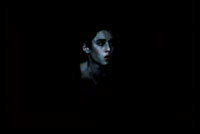
Bill Henson, Untitled #115, 2000-03
Bill Henson, however, uses chiaroscuro to create the most dramatic scenes possible. Bill Henson uses the technique to create cold monochromatic images of modern mythology as seen in "Untitled #115". Henson uses Chiaroscuro in a similar way to the film noir directors of the 1940’s and 50’s to heighten the mood and portray a message. Henson wants to portray a transcendent message and uses theatrical lighting to help present it. The use of Chiaroscuro in Henson’s “Untitled #115” presents the idea of vulnerability by using intense lighting to create melodramatic scenes.
In conclusion, chiaroscuro is constantly influencing the world around it as different innovators find new and exciting ways to implement the technique into their work. from its humble beginnings as renaissance drawings to being used in one of the most critically acclaimed films of all time shows how the technique has evolved with the times. As it's evolved its original renaissance intention of creating dramatic effect has always stayed apparent throughout but with each new artists and period something new and exciting has happened.
Word count-1219
Bibliography
https://www.nationalgallery.org.uk/paintings/glossary/chiaroscuro
https://www.britannica.com/art/chiaroscuro
http://www.yareah.com/2012/08/11/baroque-painting-chiaroscuro-vs-movement/
https://whatisfilmnoir.wordpress.com/tag/chiaroscuro-lighting/
http://fromaclearerworld.blogspot.co.uk/2012/09/chiaroscuro-in-film.html
https://storify.com/YvonneNjuguna/the-use-of-chiaroscuro-in-film
http://www.thephotoargus.com/35-gorgeous-examples-chiaroscuro-photography/
http://spokenvision.com/chiaroscuro/
0 notes